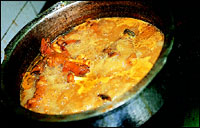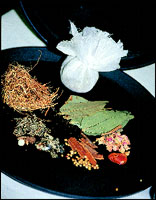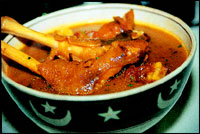


 Paya In Shorba & Salan!
Paya In Shorba & Salan!Trotters make a rich, nourishing and warming food during the monsoon, says ITC Grand Maratha Sheraton�s cuisine expert JAVED AKBAR. |
|
PAYA are trotters, the feet of goat or lamb, traditionally also cattle, a rich and gourmet food, consumed in the winter or monsoon because it is nourishing and spreads much warmth in the body. It is a breakfast food had in the early morning hours and always with breads, never rice. Restaurants all over India and especially in the Muslim dense cities serve it as the main dish for breakfast. They cook the Paya overnight and open their doors to hungry customers at 7 in the morning. By 9 o'clock, several hundred portions of Paya are over!
Paya is a Mughlai food, it came to India from Central Asia, brought by Persian traders, by entertainers and scholars along with their Chello Kebabs, their Berry Pulavs and delicate Mutton Curries. The Muslim cooks of the Hyderabad and Lucknow gharanas were quick to adapt Paya to their local cuisine. They also discovered that Paya had aphrodisical qualities and got ayurvedics and hakims to recommend them on medical prescriptions for weak and debilitated men!
The better Paya to consume is always the trotters of the goat or lamb, these are cooked with the bones, because these bones add flavour to the dish. And the Paya itself is a soft and delicate meat and easy to cook, because the animal is kid goat of a tender age, probably a year or so old, and weighing about 10 kilos. Unlike the Paya of cattle. The feet of the cow or ox are far bigger, and when they are boiled for the pot, only the meat is taken and the bones are discarded for the dish. This is a stronger Paya, more robust in its taste, and the meat is considerably tougher. It is also the poor man's Paya.
While the preparation, the recipe for the Paya Soup remains the same down the ages, the curries, the Nihari, Shorba and Salan, differ according to the people cooking them. Some people like to cook Paya with brain or tongue and these preparations are a delicacy in themselves. The Paya Nihari is cooked with herbs and spices, the Shorba is a a thin, runny soup, it is cooked without spices, and the Salan is an onion-based curry that is rich and aromatic with ginger-garlic paste, garam masala, red chilli, pounded black pepper. Adding tongue and brain to the Paya brings a different flavour to the dish. These are different meats, but soft, easy to cook, and they bring a different taste to the dish.
The best spices for a Paya preparation come in the form of the Hyderabadi potli masala. This is a rare combination of ayurvedic herbs that are tied together in a muslin cloth that is dunked into the Paya during the cooking process. It not only gives the dish flavour and spice, but also adds a bouquet to the meat. Potli masala is made up of such herbs as khas ki kadi, paan ki gad, sandal ki lakdi, saunf powder, pathar ka phool, dhania, elaichi, lavang, dalchini, gulab ki pati, whole kali mirchi. It is commercially sold in Hyderabad now.
Use it in a pressure cooker with the trotters, and you don't have to wait for 12 hours to have your Paya Nihari. It is ready in half and hour!
|
|
|

Home Page
About the mag
Subscribe
Advertise
Contact Us
 The Mughlai cooks took the Paya Soup of Persia and to this they added their nawabi touches, they added their spices, and they converted the soup into curries of varying strengths and flavours. Today Paya is consumed as a delicacy and in great quantities in Delhi, Lucknow, Hyderabad, Bhopal, and it is included on menus of Mughlai and North Indian restaurants all over the country. It is a fairly expensive food. So, the rich people buy the entire Paya, the trotters and the soup, to which they add herbs and spices, while the poor people buy only the soup. They break rotis and soak them into this soup. It makes a cheap and energising meal.
The Mughlai cooks took the Paya Soup of Persia and to this they added their nawabi touches, they added their spices, and they converted the soup into curries of varying strengths and flavours. Today Paya is consumed as a delicacy and in great quantities in Delhi, Lucknow, Hyderabad, Bhopal, and it is included on menus of Mughlai and North Indian restaurants all over the country. It is a fairly expensive food. So, the rich people buy the entire Paya, the trotters and the soup, to which they add herbs and spices, while the poor people buy only the soup. They break rotis and soak them into this soup. It makes a cheap and energising meal. Mughlai cuisine has quite a few preparations of Paya but the ones most popular are the Nihari, the Shorba and the Salan. There is also the traditional Paya Soup in which the trotters are cooked from the night before, for upto 16 hours sometimes on a slow fire, so that the juices, the marrow and the meat of the Paya becomes a soft, gelatinous pulp. They are cooked with a little turmeric and onion and when the Paya is tender, the soup is finished with ghee and seasoned with cardamom, cinnamon and cloves. Dunk a piece of soft bread into it to absorb the soup, bite into the soft, crunchy bone... truly a wonderful experience!
Mughlai cuisine has quite a few preparations of Paya but the ones most popular are the Nihari, the Shorba and the Salan. There is also the traditional Paya Soup in which the trotters are cooked from the night before, for upto 16 hours sometimes on a slow fire, so that the juices, the marrow and the meat of the Paya becomes a soft, gelatinous pulp. They are cooked with a little turmeric and onion and when the Paya is tender, the soup is finished with ghee and seasoned with cardamom, cinnamon and cloves. Dunk a piece of soft bread into it to absorb the soup, bite into the soft, crunchy bone... truly a wonderful experience! While cooking Paya, two things are most important: how you clean it, and what you spice the dish up with. Paya is cleant in two ways, with and without the skin. When it is cooked with the skin, the trotters are first lightly roasted over a fire to burn off the hair from the feet and hoof area, then washed clean. Care should be taken to see that in roasting the trotters, they don't get burnt, nor do they catch the flavour of smoke. The other method is to skin the Paya completely and leave just the bone with the meat clinging to it.
While cooking Paya, two things are most important: how you clean it, and what you spice the dish up with. Paya is cleant in two ways, with and without the skin. When it is cooked with the skin, the trotters are first lightly roasted over a fire to burn off the hair from the feet and hoof area, then washed clean. Care should be taken to see that in roasting the trotters, they don't get burnt, nor do they catch the flavour of smoke. The other method is to skin the Paya completely and leave just the bone with the meat clinging to it.